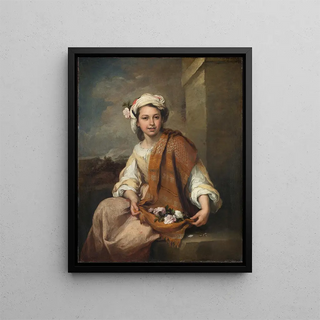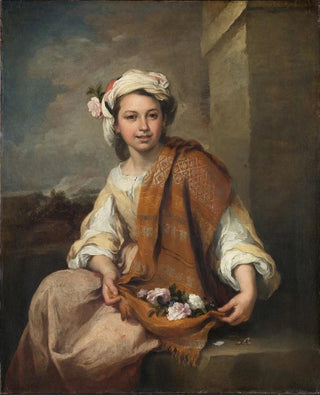Art print | The girl with flowers - Bartolomé Esteban Murillo


View from behind

Frame (optional)
In the rich and vibrant universe of Spanish baroque art, "La fille aux fleurs" by Bartolomé Esteban Murillo stands out as an iconic work, capturing the essence of childhood beauty and the delicacy of fleeting moments. This painting, which evokes gentle melancholy, transports us to a world where nature and innocence meet with rare intensity. The young girl, surrounded by blooming flowers, embodies a natural grace that invites us to reflect on the simplicity and depth of childhood. Through this art print, Murillo's work reveals itself in all its splendor, offering art enthusiasts a unique opportunity to connect with the pure emotion it exudes.
Style and uniqueness of the work
Murillo's mastery is evident in every brushstroke, every nuance of color. "La fille aux fleurs" is a perfect illustration of his distinctive style, where light plays a central role. The warm, golden hues, typical of the artist, envelop the scene in a soft, dreamlike atmosphere. The composition, carefully balanced, draws the eye toward the radiant face of the child, whose expression evokes innocent curiosity and simple joy. The flowers, delicately arranged around her, add a poetic dimension to the work, symbolizing both the ephemeral beauty of youth and the richness of nature. Murillo manages to create a visual harmony that transcends time, making this art print timeless.
The artist and his influence
Bartolomé Esteban Murillo, an emblematic figure of the 17th century, is often regarded as one of the greatest masters of Spanish baroque. His work, marked by a particular sensitivity towards children and religious subjects, profoundly influenced the artistic landscape of his time and beyond. Murillo was able to capture the soul of the characters he painted, infusing his works with a life and emotion that continue to touch modern viewers. His ability to depict light and shadow with such finesse paved the way for many artists, who saw in him an inexhaustible source of inspiration. "La fille

Matte finish

View from behind

Frame (optional)
In the rich and vibrant universe of Spanish baroque art, "La fille aux fleurs" by Bartolomé Esteban Murillo stands out as an iconic work, capturing the essence of childhood beauty and the delicacy of fleeting moments. This painting, which evokes gentle melancholy, transports us to a world where nature and innocence meet with rare intensity. The young girl, surrounded by blooming flowers, embodies a natural grace that invites us to reflect on the simplicity and depth of childhood. Through this art print, Murillo's work reveals itself in all its splendor, offering art enthusiasts a unique opportunity to connect with the pure emotion it exudes.
Style and uniqueness of the work
Murillo's mastery is evident in every brushstroke, every nuance of color. "La fille aux fleurs" is a perfect illustration of his distinctive style, where light plays a central role. The warm, golden hues, typical of the artist, envelop the scene in a soft, dreamlike atmosphere. The composition, carefully balanced, draws the eye toward the radiant face of the child, whose expression evokes innocent curiosity and simple joy. The flowers, delicately arranged around her, add a poetic dimension to the work, symbolizing both the ephemeral beauty of youth and the richness of nature. Murillo manages to create a visual harmony that transcends time, making this art print timeless.
The artist and his influence
Bartolomé Esteban Murillo, an emblematic figure of the 17th century, is often regarded as one of the greatest masters of Spanish baroque. His work, marked by a particular sensitivity towards children and religious subjects, profoundly influenced the artistic landscape of his time and beyond. Murillo was able to capture the soul of the characters he painted, infusing his works with a life and emotion that continue to touch modern viewers. His ability to depict light and shadow with such finesse paved the way for many artists, who saw in him an inexhaustible source of inspiration. "La fille






